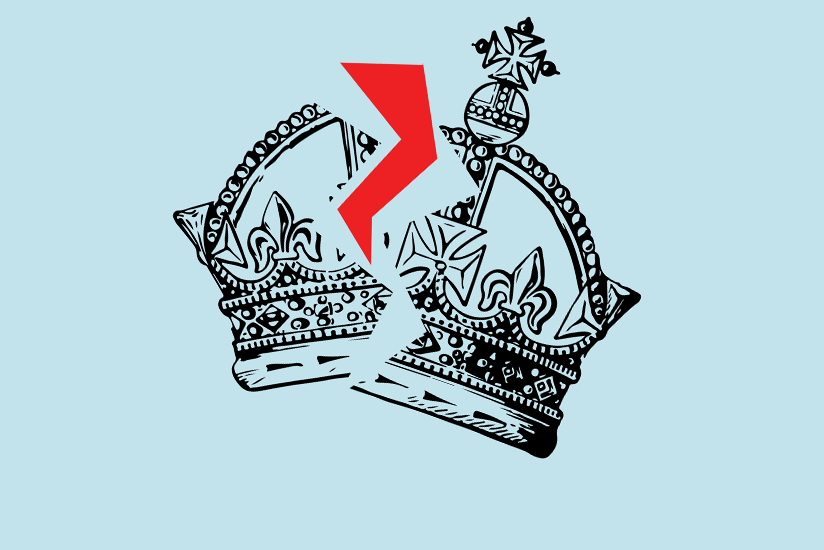
In light of the death of Queen Elizabeth II, we are republishing this article from April 2021
Recent events have raised the issue of the monarchy. There was the death of Prince Philip, accompanied by attempts to gloss over his repeated instances of racism. There was Harry and Meghan’s revelation that the racism of the British royal family extends to their own son. Prior to that, Governor General Julie Payette was forced to resign after former employees denounced her for her abusive behaviour. In Quebec, former Lieutenant Governor Lise Thibault ended up in jail in 2016 for embezzling hundreds of thousands of dollars in public funds. Her predecessor, Jean-Louis Roux, resigned following the discovery of his fascist past. No wonder then that the Crown’s popularity is at an all-time low.
Each new scandal involving the monarchy in Canada is an opportunity to remind ourselves that no other group of unemployed people receives such generous benefits. The Canadian state spends $67.1 million on the Governor General each year, while lieutenant governors are entitled to a generous “salary” of more than $100,000 a year. Another group of medieval thumb-twiddlers, the Senators, cost the federal government $114 million in 2019-2020.
Polls clearly show that people are fed up. According to the polling firm Léger, “53% of Canadians think that the British monarchy is out of date and no longer has a place in the 21st century”. These sentiments are even stronger in Quebec, where 74 per cent of respondents to a Leger poll wanted to abolish the monarchy.
When asked about the Harry and Meghan interview, Prime Minister Justin Trudeau responded by stating precisely nothing, as is his habit. “There are many institutions that we have in this country, including that big building right across the street from us, parliament, that has and is built around a system of colonialism, of discrimination, of systemic racism in all of our institutions… But the answer is not to suddenly toss out all the institutions and start over,” he said.
Federal NDP leader Jagmeet Singh said, “I don’t see the benefit of the monarchy in Canadians’ lives.” His comments reflect a common view on the left across Canada that the monarchy is a useless and expensive, but essentially harmless, piece of junk. But we must emphasize that this is a mistake.
A reactionary symbol
If for us the monarchy is an archaic and useless institution, for the Canadian ruling class it retains all its importance, and even has a greater importance today, in this epoch of revolutions and mass uprisings.
The National Post recently revealed in a roundabout way how the Canadian ruling class relies on the Crown: “In an age in which academics and an increasingly vocal group of activists frame the world in Marxian terms—bourgeoisie versus proletariat, oppressor versus oppressed—it can be hard to take stock of just how lucky we are, as Canadians, and how well served Canada is by its institutions and system of government.” What the Post half-heartedly says is that at a time when more and more workers and oppressed people are becoming aware of their own interests, the Canadian bourgeoisie needs more than ever the last line of defence provided by its institutions like the Crown and the Senate.
The Queen’s representatives in Canada normally seem to have no role other than to attend ceremonies and approve decisions made by elected officials. However, one should not think that they are harmless. If they are not normally involved in politics, it is in order to better intervene in emergency situations.
In his book The English Constitution, English constitutional scholar Walter Bagehot gave the most classical and candid explanation of the role of the British monarchy. In it, he explains what lies behind the apparent neutrality of the monarchy and its representatives:
When a monarch can bless, it is best that he should not be touched. It should be evident that he does no wrong. He should not be brought too closely to real measurement. He should be aloof and solitary. As the functions of English royalty are for the most part latent, it fulfils this condition. It seems to order, but it never seems to struggle. It is commonly hidden like a mystery, and sometimes paraded like a pageant, but in neither case is it contentious. The nation is divided into parties, but the Crown is of no party. Its apparent separation from business is that which removes it both from enmities and from desecration, which preserves its mystery, which enables it to combine the affection of conflicting parties—to be a visible symbol of unity to those still so imperfectly educated as to need a symbol.
Walter Bagehot, The English Constitution
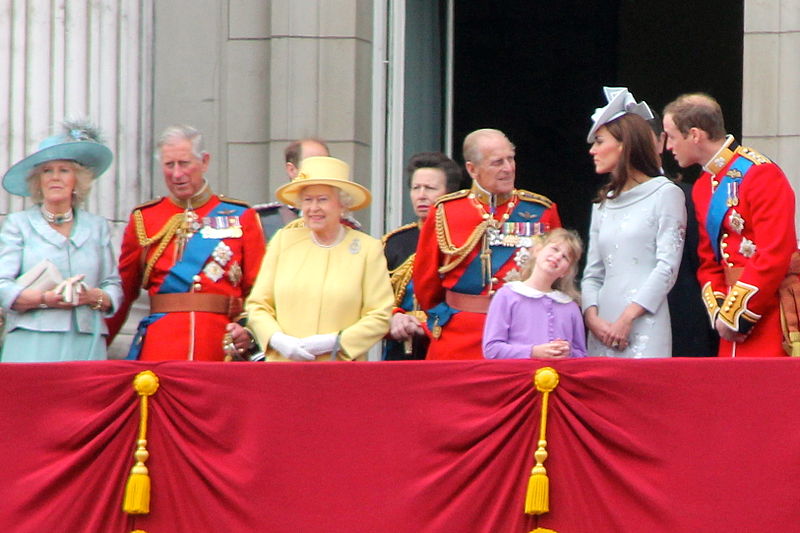
As Bagehot points out, the Crown’s appearance of neutrality helps preserve unity behind it.
GlobalNews recently interviewed Robert Finch, dominion chairman and president of the Monarchist League of Canada, who echoed this view:
The monarchy also acts as a symbol. Finch said the Queen and the Crown can be a ‘wonderful force’ for national unity and Canadian identity, which is why awards such as the Order of Canada are given in the name of the Queen, for instance… A good example of this is the Royal Tour, he added… ‘Look at the crowds that come out to see the Queen or a member of the Royal Family when they are in Canada,’ said Finch… ‘Nobody else can garner such a crowd—diverse in age, ethnicity, politics, language, social-economic background, etc.—as they can. That’s the ceremonial role of the Crown.’
Thanks to this unity, under normal circumstances purely symbolic, the Crown can serve as a reserve weapon of the ruling class in times of crisis. The Russian revolutionary Leon Trotsky explained the role of the English monarchy thus:
Royalty is weak as long as the bourgeois parliament is the instrument of bourgeois rule and as long as the bourgeoisie has no need of extra-parliamentary methods. But the bourgeoisie can if necessary use royalty as the focus of all extra-parliamentary, i.e. real forces directed against the working class. The British bourgeoisie itself has well understood the danger of even the most fictitious monarchy. Thus in 1837 the British government abolished the title of the Great Mogul in India and deported its incumbent from the holy city of Delhi, in spite of the fact that his name had already begun to lose its prestige. The English bourgeoisie knew that under favourable circumstances the Great Mogul might concentrate in himself the forces of the independent upper classes directed against English rule.
Thus, the appearance of neutrality of the Crown also serves to hide the fact that it is in fact partial. If the Crown remains neutral between the different parties that are vying for power, it is because these different parties—despite their disagreements on this or that bill, despite the fact that they are competing for elected positions—ultimately represent the interests of the same social class, the bourgeoisie. The role of the Crown is precisely to ensure that parliamentary activity and democracy remain within the bounds of this competition between bourgeois parties. Under no circumstances can constitutional democracy, in England or Canada, be used to advance the interests of working people, and especially not—the horror!—to adopt a socialist program.
As Alan Woods explains regarding the role of royalty in the UK:
It is necessary to understand that the monarchy is not simply a harmless anachronism with no powers. It is an important reserve weapon of reaction. The Queen has significant reserve powers which can be brought into play at a time of national crisis. Such powers would undoubtedly be used against a left Labour government that attempted to challenge the power and privileges of the big banks and monopolies that own and control most of Britain. Although most people do not realise it, this is the main role of the monarchy and the reason why it has been kept in being by the ruling class for so long.
Alan Woods, “Diana, the Monarchy and the Crisis in Britain”
These comments also apply generally to Canadian institutions such as the Governor General and lieutenant governors and the Senate.
A very real danger
It is for this reason that the Crown is vested with emergency powers. Walter Bagehot points out how the King or Queen could be used for anti-democratic purposes:
The king, too, possesses a power, according to theory, for extreme use on a critical occasion, but which he can in law use on any occasion. He can dissolve; he can say to his minister in fact, if not in words, ‘This parliament sent you here, but I will see if I cannot get another parliament to send some one else here.’
Walter Bagehot, The English Constitution
As the National Post points out, the monarchy has the same function here:
Canada has a constitution that is ‘similar in principle to that of the United Kingdom.’ From this, we inherited the Westminster system of parliamentary democracy, and the tradition of a sovereign who always defers to the wishes of the people’s elected representatives, but is there nonetheless as a final defence against heinous abuses of government power.
The anti-democratic power of the monarch has been used before, in the infamous King-Byng affair of 1926. On that occasion, Governor General Byng dropped his apparent neutrality and refused to grant Prime Minister Mackenzie King’s request to dissolve Parliament and call an election, choosing instead to give power to the Conservative Party. The Governor General still possesses the same powers to this day.
There is no doubt that representatives of the Crown and other feudal institutions would be brought out of the shadows to impose the will of the ruling class, if they felt that it was absolutely necessary.
But unlike the essentially “fictitious”, symbolic power of the monarchy in England, which is rooted in an unwritten constitution, monarchical institutions in Canada are firmly grounded in a written and virtually untouchable constitution.
The Canadian constitution grants significant powers to the Crown. For example, it provides that laws passed by the Canadian Parliament and provincial assemblies must be approved by the Crown. Section 9 of the Constitution Act, 1867 provides that “The Executive Government and Authority of and over Canada is hereby declared to continue and be vested in the Queen.” Section 15 grants “The Command-in-Chief of the Land and Naval Militia, and of all Naval and Military Forces, of and in Canada” to the Queen.
Although we normally tend to forget them and think of these powers as merely symbolic, they remain enshrined in law, in potential. As recently as 2013, a Canadian statute, the Succession to the Throne Act, 2013, recalled that “the Constitution Act, 1867 declares that Her Majesty the Queen is vested with executive power for Canada.”
The lieutenant-governor of Quebec, upon his appointment in 2015, emphasized in an interview that his power is “not merely symbolic” and that he would be prepared to “refuse to sign a law” if he deemed it undemocratic.
In the McAteer decision of 2013, the Ontario Superior Court of Justice reaffirmed the Queen’s powers:
Actual royal power, certainly, has ‘gradually relocated from the Monarch in person to the Monarch’s advisors or ministers’… Nevertheless, the Queen retains authority over ‘the prerogative of mercy, the grant of honours, the dissolution of Parliament and the appointment of ministers’ and other matters commensurate with her stature as national sovereign… even if most of the prerogative powers are today exercised on advise [sic] of the Prime Minister and subject to the Charter.
The Senate, too, is another feudal relic that acts as a safeguard for the ruling class. Since legislation must pass through both houses—the House of Commons and the Senate—the Senate has the power to block legislation.
The Senate has been used for anti-democratic purposes in the past, notably to prevent the repeal of section 98 of the Criminal Code. This section was passed in 1919 by the Borden Conservative government in response to the Winnipeg General Strike. It criminalized any organization that advocated for the use of force in order to change government. Its deliberately vague and wide-ranging formulation was intended in practice to terrorize and criminalize communists and trade unionists. It was used to imprison eight leading members of the Communist Party of Canada for the simple crime of belonging to a communist organization. The unelected Senate blocked its repeal at least seven times, preventing the implementation of a majority decision of the House of Commons.
The Supreme Court of Canada candidly acknowledged the Senate’s role in safeguarding the status quo in Reference re Senate Reform:
The framers of the Constitution Act, 1867 sought to adapt the British form of government to a new country, in order to have a ‘Constitution similar in Principle to that of the United Kingdom’… They wanted to preserve the British structure of a lower legislative chamber composed of elected representatives, an upper legislative chamber made up of elites appointed by the Crown, and the Crown as head of state. The upper legislative chamber, which the framers named the Senate, was modeled on the British House of Lords, but adapted to Canadian realities. As in the United Kingdom, it was intended to provide ‘sober second thought’ on the legislation adopted by the popular representatives in the House of Commons. (my italics)
Reference re Senate Reform, 2014 SCC 32, para 14-15
One of the myths peddled by supporters of Canada’s federal institutions, and the Senate in particular, is that the Senate is the champion of “the protection of minorities,” as the Supreme Court puts it. In fact, the “Father of confederation,” John A. MacDonald, was explicit about which minority the Senate is concerned with. “We must protect the rights of minorities, and the rich are always fewer in number than the poor,” he said during the debates on the creation of the Senate.
In short, the Senate is made up of an unelected elite and serves as a filter for legislation passed by the House of Commons. Senators are appointed by the Governor General on the recommendation of the Prime Minister, and hold office until age 75. In practice, senatorships, which carry a handsome salary of at least $150,600, have often been used as gifts to friends of the ruling party. Although Justin Trudeau has adopted a so-called “independent process” for selecting Senate nominees in response to the Senate expenses scandal, this does not change their unelected nature, and the Senate remains made up of people trusted by the ruling class to maintain the status quo.
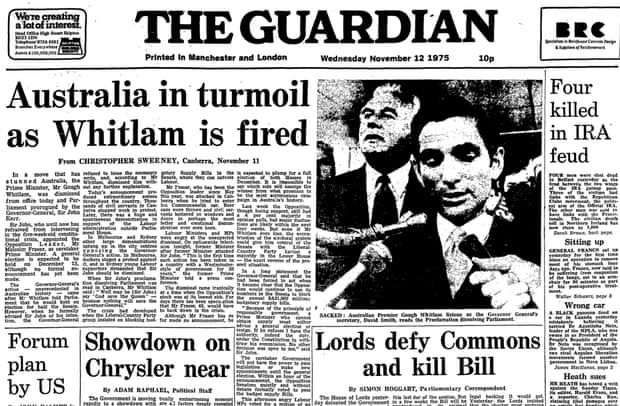
It would be wrong to imagine that the powers of these institutions are merely theoretical. Australia, another country where the British Crown remains the formal head of state, provides a good example of the kind of anti-democratic manoeuvring the Governor General could use against a socialist—or even just a too-reformist—government. During the 1975 constitutional crisis, the Governor General plotted to remove Labor Premier Whitlam and put the Liberal Party in government, despite the Liberals being in a minority. The Australian Labor Party, elected in 1972, tried unsuccessfully to implement progressive reformist policies within a parliamentary and capitalist framework. After three years, the ruling class finally ran out of patience and simply took power away from it through its tool of last resort, the Crown.
As recently as 2008, Governor General Michaëlle Jean, the representative of the British Crown in Canada, used her powers in a completely undemocratic way. She prorogued Parliament, preventing a non-confidence vote that would have brought down Stephen Harper’s Conservative government, despite the fact that the opposition parties had a majority and had agreed to form a coalition government.
Thus, more than because of the millions they cost, it is because they are reactionary and anti-democratic weapons in the hands of the ruling class that we call for the abolition of the monarchy and the Senate.
However, we have to be clear that in Canada getting rid of the monarchy is not a simple task. The Crown has a much stronger legal basis here than in the United Kingdom. The UK has an unwritten constitution, formed by custom and case law, but not codified in statute. This means that, theoretically, the British Parliament could abolish the monarchy by a simple majority vote.
Canada does not have this luxury. The monarchy and the Senate are deeply rooted in the Canadian constitution, which makes them almost untouchable by the mechanisms of bourgeois “democracy”.
The Canadian Constitution
The 1867 constitution, originally a British statute, was formally adopted as a Canadian statute—without Quebec’s consent—when the constitution was repatriated in 1982 by the government of Pierre Trudeau. The procedures for constitutional amendments adopted in 1982 are very cumbersome. According to constitutional law expert Emmett Macfarlane, Canada “arguably has the most difficult to amend constitution in the world.”
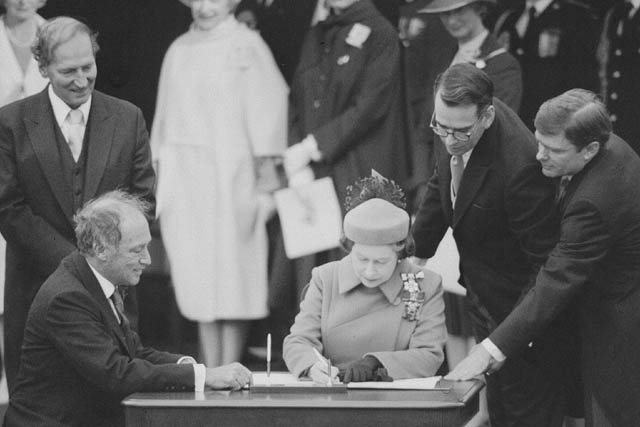
Source: Robert Cooper. Library and Archives Canada, PA-141503
Abolition of the Senate and changes to the offices of Queen, Governor General and Lieutenant Governor (and thus their abolition) require the unanimous amending formula set out in section 41 of the Constitution Act, 1982; that is, the support of the Senate, the House of Commons and each provincial legislature. The Supreme Court confirmed this in 2014 in the Reference re Senate Reform, 2014 SCC 32, after the Stephen Harper government submitted a series of questions to the Court in order to placate old Reform Party conservatives interested in Senate reform.
Such a unanimous consent represents a degree of agreement that is virtually impossible to achieve. Each province essentially has a veto, which they can use to extract concessions on all sorts of other matters. Even the unelected Senate has a veto over its own abolition!
Constitutional change is therefore a hornet’s nest for Canadian capitalists. The failures of the Meech Lake Accord in 1987 and the Charlottetown Accord in 1992 influenced Quebec’s attempt to separate in 1995. Understandably, the Canadian ruling class has little interest in repeating the experience for the sake of abolishing the monarchy—especially since, as we have seen, it is quite happy to have a monarchy. They will actively resist opening what they see as a Pandora’s box for such a trivial thing as “democracy”.
As the National Post explained :
Getting rid of the monarchy would entail sweeping constitutional reforms that would require tremendous effort and huge expense, with very little benefit. It would also necessitate a historic agreement between Canada’s increasingly disparate regions and nationalities that could very easily tear the country apart.
The National Post recently published an article in defence of the monarchy entitled “Canada’s anti-monarchists want a revolution and they should admit it”. Here the Post gets to the heart of the matter. The Canadian ruling class has placed the monarchy at the core of the Canadian political, legal and constitutional order, in order to make sure democracy doesn’t get out of (their) hand. They also made sure their own democratic institutions are practically unable to get rid of the Crown. Therefore, the growing majority of Canadians who oppose the monarchy have no means of expressing themselves. The reality is that Canada’s monarchists oppose the rule of the majority, but they do not want to admit it.
Thus, the Canadian capitalists have ensured that the monarchy cannot be abolished by parliamentary-constitutional means. The will of the majority has no way of being expressed by the institutions set up by the ruling class and their constitution. This leaves the people no choice but to assert their will by methods of direct revolutionary democracy.
Quebec and the Monarchy
If the monarchy has lost its lustre in English Canada with the latest scandals, it is absolutely hated in Quebec. Few Quebecers are happy to pay for an institution that represents their age-old oppression.
The leader of the Parti Québécois, Paul St-Pierre Plamondon, rightly stated when he tabled a motion in the National Assembly in February calling for the abolition of the monarchy: “We want to get rid of an institution that has colonial origins, that is costing us a fortune and that reminds us on a regular basis that in Quebec we are not in a free democracy, we are still in a constitutional regime that is a direct result of British and Canadian colonial power.” We agree.
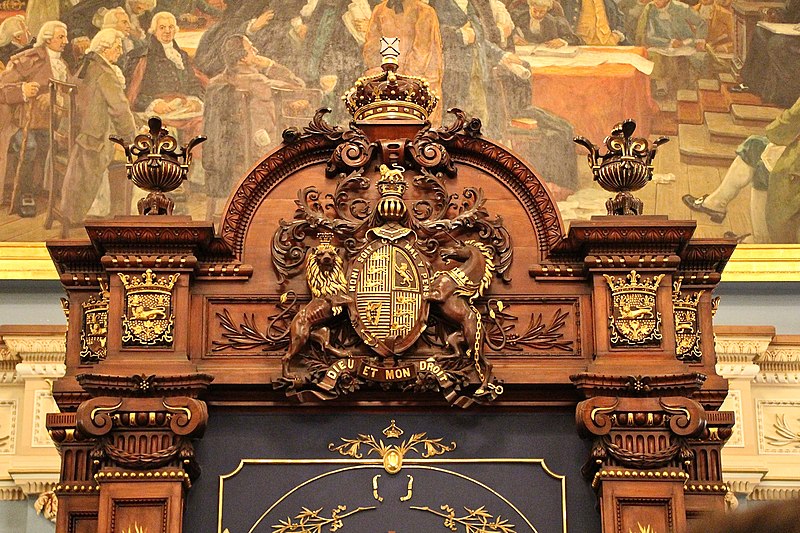
Source: Thomas1313, CC BY-SA 4.0, via Wikimedia Commons
But some nationalists are not consistent in their opposition to the monarchy. For example, the Coalition avenir Québec, which has a majority in the National Assembly, refused to support the PQ motion. The spokesperson for the Minister responsible for Democratic Institutions gave a flimsy excuse: “Quebecers have many other priorities at the moment and do not wish to see their government engage in this process, especially in a health crisis.” The mask finally came off when Legault decided to mark the death of Prince Philip by flying the Quebec flag at half-mast over Parliament on the day of the funeral. This shows what his priorities really are.
In reality, the CAQ, which claims to be the champion of Quebecers, has no more intention of touching the monarchy than the Liberal Party of Canada. They understand perfectly well how the Crown supports the continuation of capitalist rule. Rather than fight the anti-democratic federal institutions that are really oppressing Quebecers, they prefer to fight an imaginary Islamist threat.
As for the independentists, the monarchy represents for them another argument justifying independence. For them, the solution to abolishing the monarchy is obvious. Gabriel Nadeau-Dubois, leader of Québec solidaire, summed up the viewpoint of many independentists, both in the PQ and in QS. When asked about his opinion on abolishing the monarchy, he replied: “We certainly have to do it. How do we proceed? It’s very simple: we proceed with the independence of Quebec.”
In practice, this solution is not really a solution. Paul St. Pierre Plamondon accuses the CAQ of “postponing indefinitely” the abolition of the monarchy. However, if the solution is Quebec independence, it should be noted that the PQ, which itself has a tendency to postpone holding a referendum indefinitely, is not much better.
Moreover, it must be emphasized that a referendum, especially one led by the PQ, would be unlikely to lead to any real overthrow of the Canadian constitutional order. The bourgeois and petty-bourgeois nationalists of the PQ, while proclaiming themselves to be the most ardent pro-independence and anti-monarchists, would quickly cower in the event of a referendum victory.
As journalist Chantal Hébert revealed in her interviews with the protagonists of the 1995 referendum, two of the three leaders of the Yes camp, Mario Dumont and Lucien Bouchard, were not prepared to secede with a simple majority. Bouchard hoped to use a Yes vote, not to achieve independence, but to negotiate better terms of confederation with Ottawa. One can be sure that abolition of the monarchy would have been far down on their list of priorities in such negotiations. This attitude is typical of bourgeois nationalists, for whom independence is often only a threat to be used against the Canadian bourgeoisie in order to better assert their own (economic) interests over Quebec.
There is also little chance that the Canadian ruling class would allow something as trivial as the democratic will of a majority of Quebecers to dismantle the Canadian federation. The separation of a province representing 20 per cent of the country’s GDP would be unacceptable to the Canadian ruling class. In fact, Canada’s Prime Minister at the time of the 1995 referendum, Jean Chrétien, later admitted that he planned to refuse to recognize a Yes vote, if one were to win.
The Canadian state would use all legal means at its disposal to block a secession attempt. In particular, after the 1995 referendum, the Canadian ruling class acquired an anti-democratic weapon, the Clarity Act, to block separation through referendum. Among other things, the Act requires that the House of Commons approve the referendum question and decide whether a sufficient majority is obtained. It essentially allows the House of Commons to refuse to recognize the democratic will of a majority of Quebecers.
In the event of a referendum victory, Quebec nationalists would face the same kinds of legal and constitutional obstacles as Canadian opponents of the monarchy. The Canadian constitutional order cannot be overturned by the democratic will of the people. As the Supreme Court explained in Reference re Secession of Quebec, [1998] 2 SCR 217 :
Quebec could not, despite a clear referendum result, purport to invoke a right of self-determination to dictate the terms of a proposed secession to the other parties to the federation. The democratic vote, by however strong a majority, would have no legal effect on its own and could not push aside the principles of federalism and the rule of law, the rights of individuals and minorities, or the operation of democracy in the other provinces or in Canada as a whole. Democratic rights under the Constitution cannot be divorced from constitutional obligations.
In short, Quebec nationalists, like anti-monarchists in English Canada, should come to terms with the fact that the democratic will of the majority cannot be enforced within the current legal framework. Independentists who think that it would necessarily be easier to get rid of the monarchy by separating from Canada than to get rid of the Crown in Canada as a whole are royally mistaken. In both cases, the Canadian ruling class prevents us from going through democratic means within the present constitutional framework, and therefore forces us to resort to revolutionary means.
But then how do we abolish the monarchy? With support for abolishing the monarchy at record highs across the country, it would actually be counterproductive to limit the movement to a purely Quebecois movement for independence. Marxists fight shoulder to shoulder with Quebec nationalists against reactionary institutions like the British Monarchy and the Canadian state but we fight to unify the workers and oppressed across the entire Canadian state to do so. Such unity on a class basis is the path we must take if we are really serious about abolishing the monarchy.
Indigenous Peoples and the Monarchy
Finally, there is one more element to consider in the abolition of the monarchy. Some have contended that the abolition of the monarchy in Canada may be a cause for concern for Indigenous people. The British Crown, through the Royal Proclamation of 1763, established that title to land belonged to First Nations unless it was formally extinguished by treaty. Various treaties were subsequently concluded between the Crown and the First Nations.
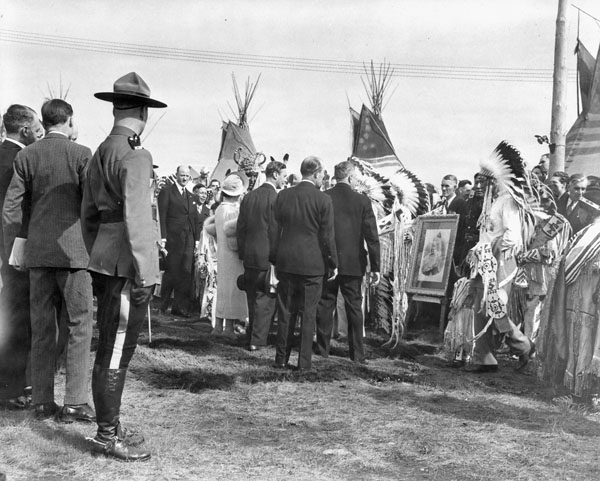
in Calgary, 1939. Source: Public Domain
For this reason, First Nations leaders often meet with members of the Royal Family during Royal visits to remind them of the promises of their ancestors. Following Julie Payette’s resignation as Governor General, the Confederacy of Treaty Six sent a letter directly to the Queen of England expressing its concerns.
This led Nathan Tidrige, an author who has written about the relationship between Indigenous people and the Crown, to come to the defence of the monarchy. In an article entitled “Abolishing monarchy in Canada will complete colonization of Indigenous people,” he argued against abolishing the monarchy under the guise of defending Aboriginal rights.
In doing so, he white-washes the historical role of the British Crown. According to him, the “Crown was co-opted into the drive to forcibly settle this continent… However, that was not the original vision for this land.” Thus, it is alleged that Canadian settlers were the ones who oppressed Indigenous people, against the will of innocent British royalty, friends of the first peoples of the Americas! That is quite something. If we were to believe Mr. Tidrige’s version of events, the fate of the royal family would be terribly tragic. Poor things, seeing their names forever associated with the plundering, enslavement and slaughter of so many peoples, from China to Ireland, South Africa, India and the Americas despite their innocence! In fact, as Anishinabe journalist Tanya Talaga says, “the monarchy has spent centuries looking the other way while crimes of colonialism were being committed.”
It would also be wrong to assume that the British Crown recognized Aboriginal title to their lands out of selflessness and friendship with them. As we explain in our document Indigenous Struggle and the Fight for Socialism :
Treaties played an important role in preparing the land and Indigenous people for capitalist development. The legal basis for treaties was twofold: the British North America Act, which gave the Crown authority to deal with Indigenous people, and the Royal Proclamation of 1763, which stated that all legal title to land rests with the Indigenous peoples unless formally extinguished via treaty. This proclamation is the legal basis for the Aboriginal land title claims which Indigenous people use in their struggle to the present day. However, as previously mentioned, the Royal Proclamation was never intended to defend Indigenous land rights, but to prevent the colonies from acquiring land directly in order to ensure a monopoly on land for the British Crown. Much manipulation and misrepresentation was used during treaty negotiations to defraud Indigenous people from large swaths of their land and push them onto non-arable and lower-quality land.
Thus, this attempt to distinguish the good British Crown from its bad Canadian settlers who acted without its consent does not hold water. That said, while there is no doubt that the British Crown has blood on its hands, the concerns of some Indigenous people must be acknowledged. Treaties with the British Crown are still a last line of defence for many First Nations against encroachment on their territory by Canadian governments and capitalists. There is a fear that the end of the monarchy could extinguish these treaties.
However, others have argued that, from a legal point of view, the abolition of the monarchy should not undermine treaty rights. According to this line of reasoning, treaties should be seen as being concluded between sovereign nations, and therefore belong to international law. Under international law, “When one form of government replaces another, the new government acquires the treaty rights and obligations of its predecessor. Thus, going from a monarchy to a republic does not affect Canada’s treaties with Indigenous people. To argue otherwise is to argue against Indigenous sovereignty.”
Whatever the case may be from a legal standpoint, one government after another since colonization has shown little regard for the rule of law. In this sense, one can understand the fear of some Indigenous people. If the monarchy were abolished by a bourgeois government, it is likely that the bourgeoisie would use the opportunity to try to free itself from its treaty obligations.
However, several points need to be made here. First, as we have already explained, it is highly unlikely that a bourgeois government would attempt to abolish the monarchy. The monarchy plays an important role for the ruling class, and the cumbersome constitutional procedures would risk tearing the country apart. In fact, it is incredibly hypocritical of many right-wing columnists to be using the rights of Indigenous people as an argument for maintaining the monarchy!
More importantly, this highlights once again the fact that Indigenous rights will never be protected under the capitalist status quo. The federal capitalist state and all of its anti-democratic and colonial institutions are pillars of the historical oppression of Indigenous people, as well as of Quebecers and Canadian workers in general. It is frankly absurd to defend a core institution of the capitalist status quo on behalf of Indigenous people.
On the contrary, the need to protect treaty rights lends weight to the argument that a revolution is necessary to abolish the monarchy. The oppression of Indigenous people is a necessity for the Canadian capitalist class. First Nations defending their territory is an obstacle to capitalist development, as has been seen consistently throughout history. For example, the Haudenosaunee land defenders of 1492 Landback Lane, on Six Nations territory in Ontario, are currently blocking a real estate development that is occurring without their consent.
The real estate developers and resource extraction companies who want to drive the First Nations off their land are also the enemies of the Canadian and Quebec working class. A socialist revolution that would take power away from these capitalist parasites would benefit the working and oppressed classes of all peoples in the country now called Canada. Therefore, solidarity is possible between Indigenous, Québécois and Canadian workers for the abolition of the monarchy, provided that the abolition of the monarchy is linked to a revolutionary program capable of ousting our common enemies.
Abolish the monarchy!
In an era of economic crisis, growing inequality and unending pandemic, many people are coming to the conclusion that the status quo is no longer tenable. While essential workers risk their lives for scraps, the ultra-rich continue to grow richer and richer in the safety of their mansions. Yet Canada retains its legendary political stability. But beneath the surface, anger is brewing.

In the wake of the crisis of capitalism, insurrectionary movements have erupted in one country after another in recent years. At some point, impoverished, downtrodden, exhausted working Canadians will mobilize to demand an end to the deep inequalities that we now suffer. They will demand profound changes to the political and economic order. But the rule of capitalists is based on the exploitation of workers, and therefore on this inequality. They cannot allow the workers to have a real say.
At this point, the Senate, the Governor General, the lieutenant governors and the Queen of England will serve as the last line of defence for the faltering rule of the capitalists. For workers to emancipate themselves to achieve true economic and political democracy, we will have to abolish the monarchy.
But the Canadian ruling class has specifically written its constitution so that there is no institutional way to abolish the monarchy. For Canadian capitalists, the will of the people to democratically change the political system is irrelevant. Therefore, we can only conclude that the system cannot be reformed and the monarchy cannot be eliminated without revolution.
The struggle for the abolition of the monarchy and the Senate should therefore be carried out through a revolutionary movement. For such a movement to succeed, it would have to unite the workers of the various peoples of Canada. Only a socialist program could achieve this unity.
A socialist republic will be the first instance of a true democracy. By placing the major levers of the economy under the democratic control of the workers, we will have not only a political democracy, but also an economic democracy. Instead of electing once every four years the comfortable crooks who will represent our exploiters, all leadership positions will be recallable at any time and paid no more than the average worker’s salary. We will thus end the dictatorship of Bay Street, and consign to the dustbin of history the feudal relics of hereditary monarchy.
If you want to abolish the monarchy, and establish a true democracy, join us in this struggle.
Down with the oppressive federal state!
Down with monarchical and feudal institutions and relics! Abolish the offices of governor general and lieutenant governor and the Senate!
Tear up the anti-democratic Canadian constitution!
For a socialist republic of Canada, in free union with a socialist republic of Quebec!

